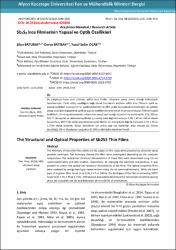Sb2S3 ince filmlerinin yapısal ve optik özellikleri
Citation
Baturay, Ş. , Batıbay, D. & Ocak, Y. S. (2019). Sb2S3 İnce Filmlerinin Yapısal ve Optik Özellikleri . Afyon Kocatepe Üniversitesi Fen Ve Mühendislik Bilimleri Dergisi , 19 (2) , 286-291 . Retrieved from https://dergipark.org.tr/tr/pub/akufemubid/issue/48783/429200Abstract
Bu çalışmaya konu olan antimon sülfür ince filmler ultrasonik sprey piroliz tekniği kullanılarak hazırlanmıştır. Farklı alttaş sıcaklığına bağlı olarak hazırlanan antimon sülfür ince filmlerin optik ve yapısal özellikleri sırasıyla UV-vis spektrofotometri ve XRD analizi kullanılarak incelenmiştir. Bu şekilde alttaş sıcaklığını değiştirerek optik ve yapısal özelikleri kontrol etmek mümkün olmuştur. Filmlerin optik özellikleri, UV-vis spektrometresi kullanılarak enerji bant aralığı ölçümleri ile analiz edildi. 275, 300 ve 325 °C’ de yapılan ve tavlanmamış filmler için enerji bant değerleri sırasıyla 2.36, 2.47 ve 1.84 eV olarak bulunurken, 500 °C’de sülfür ortamında tavlanan filmler için enerji bant değerleri sırasıyla 1.73, 1.76 ve 1.77eV olarak bulundu. Bütün yönelimler için mikro yapı (e), düzlemler arası mesafe (d), kristal büyüklüğü (D) ve dislokasyon yoğunluk (δ) XRD analizi kullanılarak belirlendi. The Antimony thiorea thin films which are the subject of this study were prepared by ultrasonic spray pyrolysis technique. The Antimony thiorea thin films were investigated depending on the substrate temperature. The optical and structural characteristics of these films were determined using UV–vis spectrophotometry and XRD analysis, respectively. By changing the substrate temperature, it was possible to control the optical and structural characteristic of the films. The optical properties films were analysed by energy band gap measurements using UV–vis spectrophotometry. While the band gaps of as grown films found to be 2.36, 2.47 ve 1.84eV, the band gaps of the films at annealing 500°C found to be 1.73, 1.76 ve 1.77eV. XRD analysis was used to determine the microstrain (e), lattice spacing phase (d), crystallite size (D) and dislocation density (δ) for all orientations.
Source
Fen ve Mühendislik Bilimleri DergisiVolume
19Issue
2Collections
- Cilt 19 : Sayı 2 [25]



















